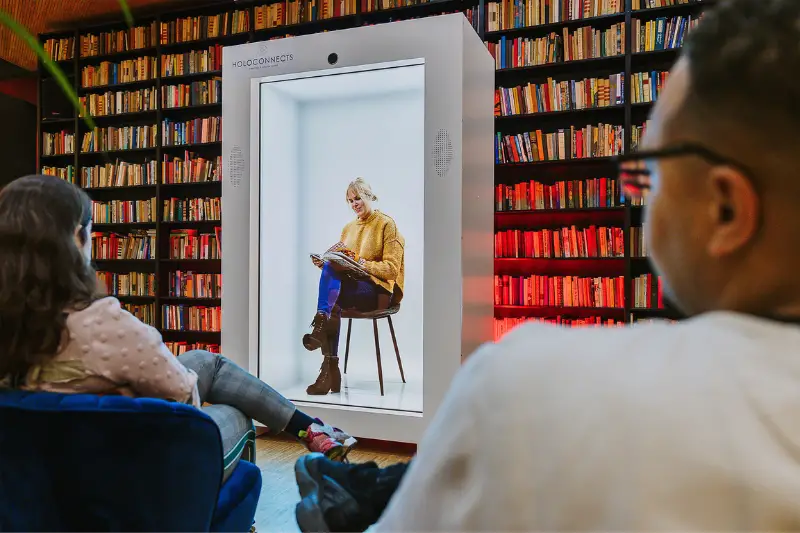Click here to get this post in PDF
Hologram technology has been present for decades now. Its accessibility and affordability have improved in recent years; hence more advertisers are using it to create immersive and interactive experiences for their customers.
Crowded markets create a strong demand for experiential marketing techniques like interactive experiences. These benefits are made possible by modernized holographic technologies used by big brands today.
This post will discuss adverts’ adoption of futuristic advertising tools like dazzling digital imagery – covering past successes and practical insights on how holograms can benefit from this state-of-the-art method.
The Rise of Hologram Technology in Advertising
Hologram technology uses light beams to produce astonishing three-dimensional images that appear suspended in midair. While existing technologies enabled such spectacles a long time ago, it wasn’t until recently that marketing professionals like Holobox from Holoconnects realized their value as attention-grabbing devices.
Case Studies: What is Holobox?
The Holobox is a plug-and-play device from Holoconnect, making it astonishingly easy to operate despite its complicated technology. The Holobox can transport holograms to any area with electricity and an internet connection. To demonstrate this process, Holobox uses a transparent LCD panel, a lightbox mainly developed for the Holobox, which is placed behind that screen to generate visual depth in the Holobox. This provides a holographic illusion in the Holobox.
Holobox technology is equipped with the following;
- The transparent LCD screen is 86’’ for a life-size, realistic holographic projection.
- 20-point IR Multitouch for Control of the Holobox with sophisticated touch technology.
- Built-in Bose speakers with exquisite sound with discretely hidden Bose speakers.
- Anti-reflective Glass with the least amount of reflection is ideal.
- An optional 4K video conference that can be used to introduce yourself virtually.
Holoconect has worked with companies like Deloitte Vodafone, Festo, Funx, OLAF, and ASML.
Enhancing Brand Experiences with Holograms
Hologram technology revolutionizes the advertising industry by providing opportunities for creating captivating brand experiences in an immersive setting by leveraging this technology.
Advertisers can turn static ads into dynamic marketing tools that transport their target audience into a virtual world rich in visual stimulation. This experience allows customers to interact with goods and brands like never before possible through traditional media forms.
This interactive element undoubtedly contributed to garnering attention from eager customers. The hologram experience helped to create excitement around the new phone and generated a lot of interest from potential buyers.
Successful Hologram Advertising Campaigns
To portray the importance of hologram technology in advertising more clearly, let us analyze specific cases where such methods have led to successful outcomes in promotion campaigns.
KFC Colonel Sanders Hologram
The KFC Colonel Sanders hologram was another successful hologram advertising campaign. The hologram, displayed on a billboard in Times Square, interacted with passersby and encouraged them to try the new menu item. The hologram experience helped to create buzz around the new menu item and generated a lot of interest from potential customers.
Samsung Galaxy S10 Launch in Singapore
The Samsung Galaxy S10 launch in Singapore was also a successful hologram advertising campaign. The campaign featured a holographic display that showcased the phone’s features and allowed customers to interact with it in a virtual environment. The hologram experience helped to create excitement around the new phone and generated a lot of interest from potential buyers.
Future Potential and Opportunities
Hologram technologies are constantly evolving and becoming more widely available, presenting ample prospects for advertisers to connect effectively with their intended audiences.
The retail industry is one area where hologram technology has much potential. Using holograms, retailers can create immersive and interactive shopping experiences that engage customers and increase sales.
For example, a clothing store could use holograms to create virtual dressing rooms where customers can see how different outfits look without trying them on physically.
The events industry is another area where hologram technology has much potential. Using holograms, event organizers can create engaging and memorable experiences for attendees.
Final Word
In conclusion, hologram technology is an exciting and rapidly evolving field with enormous advertising potential. Brands looking to stand out in a crowded marketplace should consider incorporating holoconnects into their marketing strategies. Some businesses use an unconventional approach to attract potential customers by designing immersive and interactive experiences.
With this method, organizations can showcase their products and services in a unique format that stands out from traditional marketing tactics. With the continued evolution of this technology, the possibilities for hologram advertising are endless.

